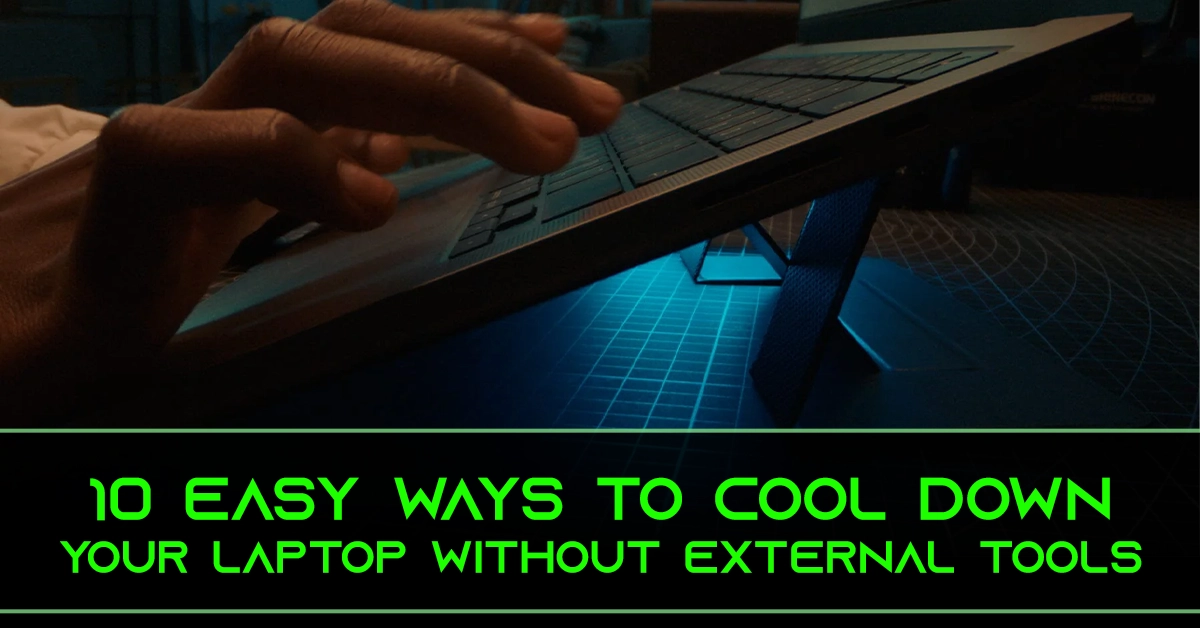10 Easy Ways to Cool Down Your Laptop Without External Tools

Keep Your Laptop Cool Naturally
Is your laptop heating up too fast? You’re not alone. Overheating is one of the most common issues faced by laptop users in Bangladesh, especially during the summer months. High temperatures not only slow down performance but also reduce the lifespan of your device. Most people immediately look for external cooling pads or fans, but did you know you can reduce heat without any external tools?
At Area 51, we understand how important it is to keep your laptop running smoothly—whether you’re gaming, working, or studying. That’s why we’ve put together a list of 10 proven methods to cool down your laptop using just built-in settings, habits, and smart usage techniques. These methods are easy, cost-effective, and can be done right now.
Let’s dive into the most effective ways to prevent overheating without spending extra money or relying on third-party accessories.
1. Use Your Laptop on a Hard, Flat Surface
Always place your laptop on a flat and hard surface like a table, wooden desk, or tray. Soft surfaces such as beds, pillows, or couches block airflow from the bottom ventilation areas, trapping heat inside. A flat surface ensures maximum air circulation and keeps your device from overheating.
2. Clean the Air Vents Regularly
Dust and dirt are enemies of proper ventilation. Use a soft brush or a compressed air can to clean out the air vents gently. Blocked vents lead to internal heat buildup, which slows down performance and risks hardware damage over time.
3. Adjust Power Settings to Reduce Load
On both Windows and macOS, switching to “Power Saver” or “Battery Saver” mode lowers CPU activity. This minimizes heat generation by reducing background processes and clock speed. You can also limit background apps manually via Task Manager or Activity Monitor.
4. Close Unnecessary Tabs and Background Apps
Every open browser tab or background application uses CPU and RAM resources. The more you multitask, the hotter your laptop gets. Make it a habit to close what you’re not actively using—especially memory-heavy apps like Chrome, Photoshop, or games running in the background.
5. Keep Your Laptop’s BIOS and Drivers Updated
Outdated BIOS or GPU drivers may mismanage fan speed or thermal controls. Manufacturers often release updates to optimize performance and thermal management. Visit your brand’s official support page or use tools like Dell Update or Lenovo Vantage to stay updated.
6. Use Built-In Performance Modes Wisely
Modern laptops come with thermal profiles like “Quiet,” “Balanced,” or “Performance.” Choose the mode that suits your task. If you’re browsing or streaming, “Quiet Mode” keeps fans low and reduces CPU stress, effectively lowering temperature without manual intervention.
7. Work in a Cooler Environment
Using your laptop in an air-conditioned room or a well-ventilated space can help lower its internal temperature. Avoid direct sunlight or hot spots like kitchens. Environmental temperature has a direct effect on your laptop’s cooling system.
8. Avoid Blocking the Exhaust Area
The exhaust vent is typically located at the back or sides of your laptop. If something is obstructing that airflow—like a wall, another device, or even your hand—it can cause rapid heat buildup. Give it enough breathing space during use.
9. Undervolt Your CPU (For Advanced Users)
Undervolting is a safe method to reduce the power supply to your processor without sacrificing performance. It can drastically lower heat output. Use tools like Intel XTU or ThrottleStop (only if you’re tech-savvy) and always follow proper undervolting tutorials.
10. Hibernate Instead of Sleep Mode
While Sleep Mode keeps some background processes running, Hibernate shuts everything down while preserving your session. It uses zero power and prevents passive heating, especially helpful if you’re moving around with your laptop in a bag.
Final Words: Heat Control is in Your Hands
You don’t always need expensive coolers or fans to keep your laptop from overheating. With these 10 easy and effective methods, you can maintain optimal temperature, improve performance, and extend the life of your device—all without spending a single taka.
If you’re using an older laptop or your thermal paste has dried out, it might be time for an upgrade. Visit Area 51 for the best laptop deals in Bangladesh—from gaming rigs to ultrabooks, we’ve got the perfect machine for every need.
💡 Frequently Asked Questions (FAQ)
1. Why does my laptop overheat so quickly?
Laptops often overheat due to poor airflow, dust buildup in vents, heavy multitasking, or using the device on soft surfaces like beds or cushions. Keeping your system clean and following proper usage habits can prevent overheating.
2. Can overheating permanently damage my laptop?
Yes, continuous overheating can damage internal components like the CPU, GPU, and battery. It may also cause system crashes, reduced performance, or even hardware failure over time.
3. Is it safe to use software tools to control fan speed?
Yes, as long as you use trusted software from reliable sources (like SpeedFan or manufacturer utilities). However, tweaking fan speeds without understanding the settings can be risky, so it’s better to follow manufacturer-recommended tools
4. When should I consider using a cooling pad
If your laptop still overheats after trying these built-in fixes, or if you’re running heavy tasks like gaming or video editing for hours, an external cooling pad can help further improve airflow and lower temperatures.
